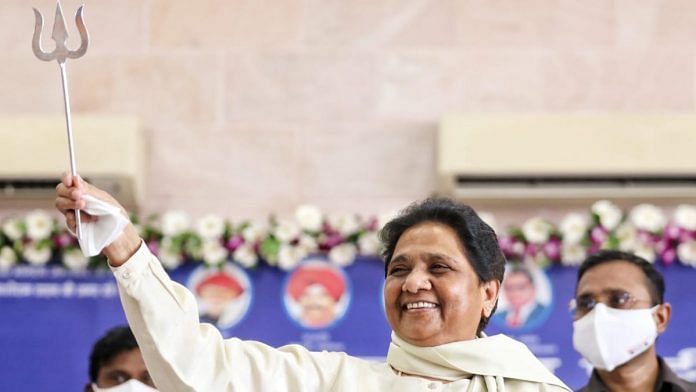Most political observers seem a bit confused about the political choices of Dalits and their electoral mood in the upcoming Uttar Pradesh assembly election in 2022. One of the reasons for this confusion is that Mayawati, the chief of the Bahujan Samaj Party, has not yet started her election campaign and there is a media-created perception that her political base is weakening by the day. Dalits in Uttar Pradesh are an influential vote. Their population is around 21.6 per cent, which includes 66 Dalit castes.
In my view, an appropriate analysis of the polarisation of Dalit voters at this moment may be premature. It can be done when Mayawati comes into the fray. But if someone overcomes the media perception, visits Dalit hamlets in rural Uttar Pradesh and attempts to assess their political mood, they may form a partial picture. It could give us a clue to understanding the direction of Dalit political mobilisation.
The Mayawati and BSP ‘attraction’
While trying to understand the Dalit political mood, I observed that a large section of Jatav voters in various regions of Uttar Pradesh still seem in favour of Mayawati-led BSP. It is also true that a section of urban voters can sway towards political parties like the Samajwadi Party (SP), Bharatiya Janata Party (BJP), Rashtriya Lok Dal (RLD) and Congress. The Azad Samaj Party, led by Chandrashekhar Azad, has also successfully mobilised a section of Jatav community youth in its favour, but most Jatav males and females of various age groups are still drawn to Mayawati.
To break down the Dalit population’s ‘attraction’ to Mayawati, political groups need to work hard to win them on the ground. Don’t be fooled into thinking that they will vote for any other party if someone just criticises Mayawati. If you establish a close connection with them, they may eventually confess quietly: “Bhaiyya hum kahan jayenge? Hum to is bar bhi hathi ke sath hi rahenge“. (Brother, where else can we go? We will be with the ‘elephant’ this time too.) It is true that there are complaints and disillusionment among a section of Jatav voters, but that does not mean they have decided to leave Mayawati.
Although there is a fragmentation of non-Jatav votes among Dalits in various hamlets in eastern Uttar Pradesh, we have observed a strong bias for both BSP and SP within communities like Pasi, Dhobi, and Kori, who are major Dalit communities after Jatavs. The Samajwadi Party has organised Dalit Sammelans in various parts of UP to bring the Dalit population into its fold. In fact, the SP is trying to extend its social alliance to add Dalits and Most Backward Castes in UP by forming alliances with smaller caste-based parties and organising caste and community conferences. The BJP also seems to be more or less successful in politically mobilising sections of these communities for the upcoming election. It is trying to retain its non-Jatav Dalit support by giving them representation in the party and election. The party has also organised various samajik samvad (community debate) programmes to interact with and mobilise the bigger non-Jatav Dalit groups and Other Backward Classes (OBCs).
Also Read: How is the ‘Yogi will win’ story spreading in UP? Ask the mahaulis
BJP, RSS and small Dalit communities
Apart from these dominant Dalit communities, there are around 50 smaller ones such as Mushar and Hari who form a numerically impressive vote bank when combined. These communities have yet to produce their own politics and are still waiting for electoral mobility. Socio-economically, these are the most marginalised Dalit communities. Most of them are landless labourers without any stable occupation and struggling to earn enough for two meals. It is among these smaller Dalit castes, that you may find most support for the BJP. Prime Minister Narendra Modi’s welfare policies like Pradhan Mantri Ujjwala Yojana, free ration and pension schemes, and Pradhan Mantri Awas Yojana are quite popular among them. The on-ground work of Rashtriya Swayamsevak Sangh (RSS) for such communities also gives an edge for the BJP in this election. We also observed that some of these communities vote under the influence of dominant local leaders or communities. So, the pattern of their voting varies from constituency to constituency.
Earlier, BJP’s politics focussed on non-Jatav mobilisation, but we are seeing a shift ahead of the 2022 Uttar Pradesh elections. It is also trying to mobilise some of the Jatav votes in its favour. Sections of politically ambitious urban Dalit voters already admire the BJP and the party is going to launch a special campaign to mobilise them in different parts of Uttar Pradesh. The BJP is also trying to project Jatav leaders like Baby Rani Maurya and Dushyant Gautam as the Jatav faces in UP politics.
We will soon find out if a large section of Dalit voters will vote homogeneously for one party or if the vote will get fragmented between various political parties due to the rise of political aspirations among an upwardly mobile section of marginal communities.
The author is Professor and Director at the G.B. Pant Social Science Institute, Allahabad. He tweets @poetbadri. Views are personal.
(Edited by Srinjoy Dey)



